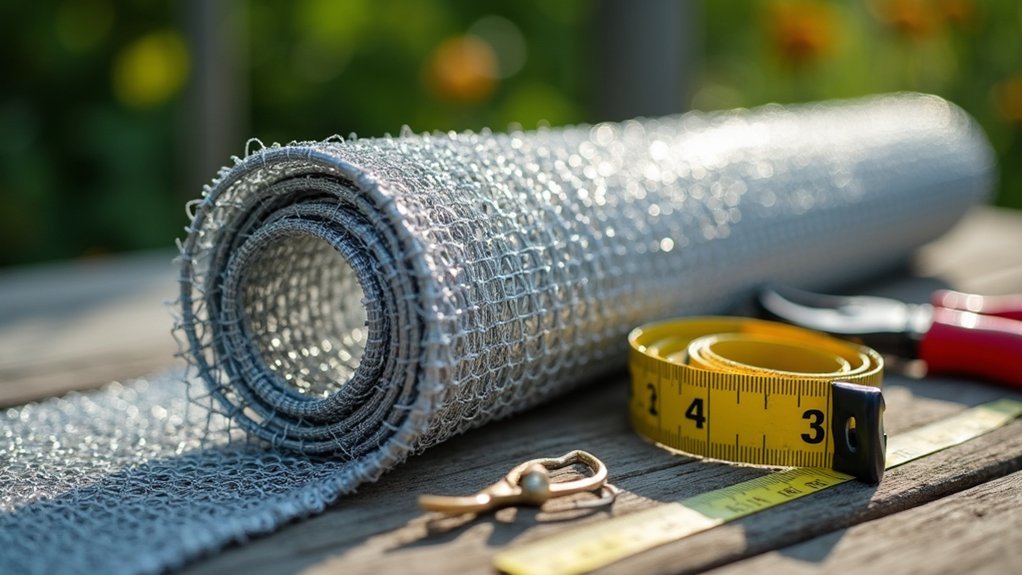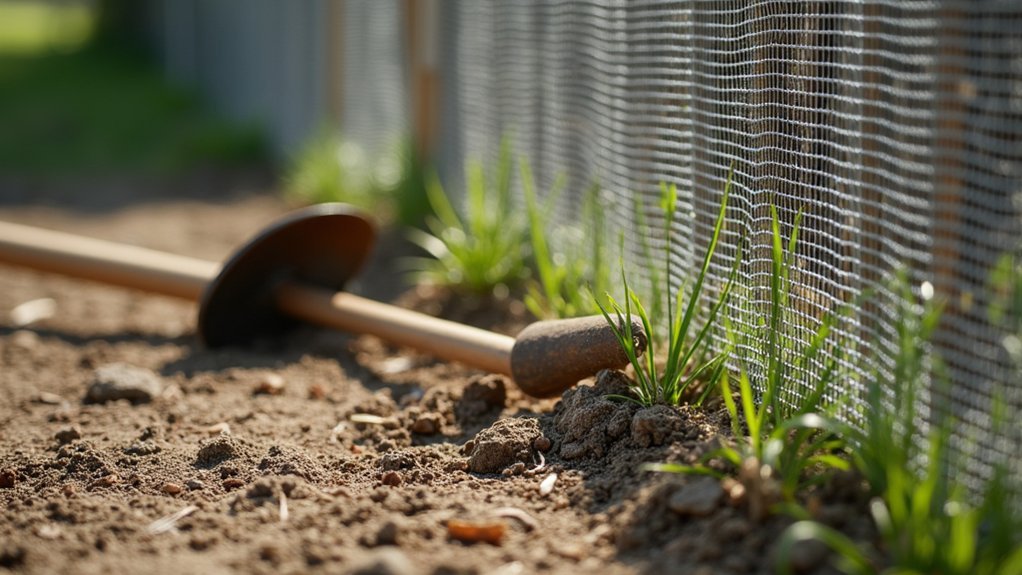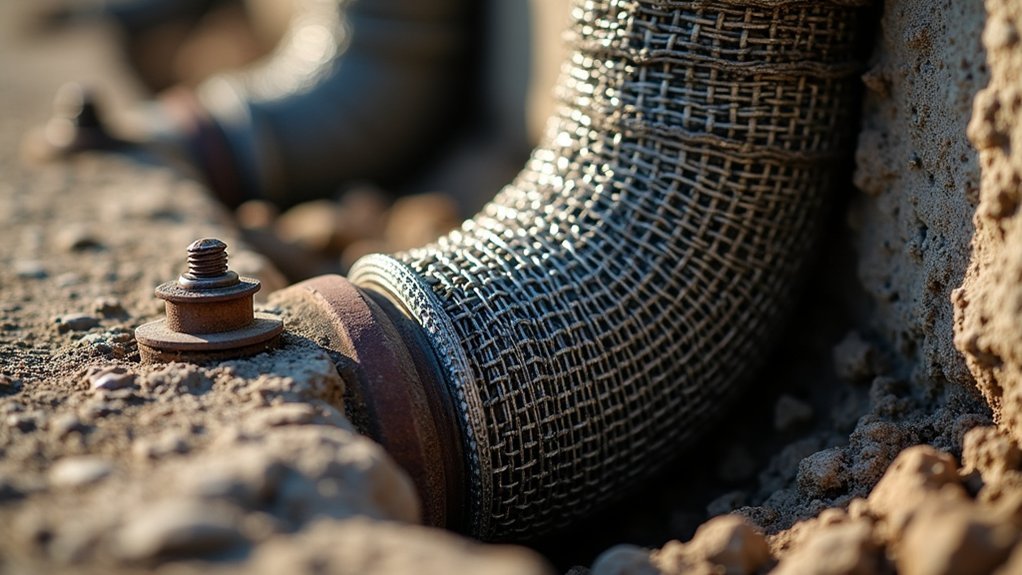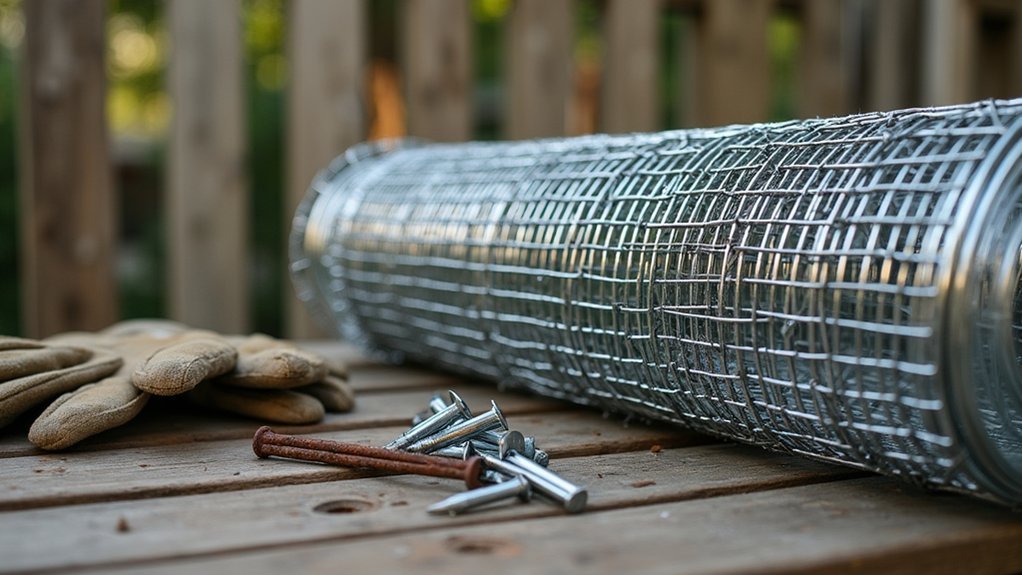To effectively install hardware cloth for rodent prevention, choose 1/2-inch mesh for rats or 1/4-inch for mice. Cut the galvanized cloth to size with wire cutters, allowing extra for overlap. Secure all edges with metal strips or screws, and seal gaps with caulk. Focus on vents, pipes, foundation gaps, and crawl spaces. Always wear protective gloves and eyewear during installation. Proper application creates a lasting barrier that keeps unwanted visitors permanently out.
Understanding Hardware Cloth Selection and Specifications

When selecting hardware cloth for rodent prevention, you’ll need to understand the specific requirements for different pests. For effective barriers, use 19-gauge, 1/2 x 1/2-inch mesh for rats and 24-gauge, 1/4 x 1/4-inch mesh for mice. These specifications prevent rodents from squeezing through entry points, as mice can fit through gaps as small as 1/4 inch.
Choose galvanized options for maximum durability and resistance to rust, ensuring long-term protection against persistent gnawing.
Hardware cloth is particularly effective when installed on vertical surfaces where rodents typically attempt access. For proper installation, make sure the material is securely fastened with metal strips or screws at all edges. This prevents rodents from exploiting weak spots and maintains the integrity of your protective barrier.
Tools and Materials Needed for Installation
To properly install hardware cloth as a rodent barrier, you’ll need basic tools like wire cutters, a drill, and safety equipment including gloves and eye protection.
Select 19-gauge galvanized mesh for rat exclusion or 24-gauge for mice, ensuring you’ve measured accurately with extra material for adjustments.
Don’t forget essential supplies such as metal strips, screws, and caulk to create secure, gap-free installations that effectively block rodent entry points.
Basic Tools List
Preparation with the right tools makes rodent-proofing work efficient and effective.
Before installing hardware cloth, gather these essential items:
For cutting and fitting, you’ll need sharp scissors or wire cutters to trim the mesh precisely to your measurements. A measuring tape is vital for accurately sizing all areas requiring protection.
To secure the hardware cloth, have a drill or screwdriver ready along with appropriate screws or nails and metal strips for creating tight seals against surfaces.
Don’t forget safety equipment – always wear protective gloves when handling the potentially sharp edges of cut hardware cloth, and use safety glasses to shield your eyes from flying debris during installation.
Finally, keep sealant or caulk handy to fill any gaps between the hardware cloth and surrounding frames, ensuring rodents can’t find entry points.
Specialized Hardware Selection
Now that you’ve gathered your general tools, selecting the right specialized hardware will determine your rodent-proofing success.
Choose galvanized hardware cloth with specific mesh sizes – 1/2 x 1/2-inch for rats or 1/4 x 1/4-inch for mice – to guarantee effective rodent exclusion.
For secure attachment, you’ll need metal strips or screws that resist gnawing attempts.
Don’t forget quality sealant or caulk to fill gaps around the installation edges, creating a truly rodent-proof barrier.
Your tools should include sharp scissors or wire cutters for precise fitting of the hardware cloth over vulnerable openings.
For personal safety during installation techniques, invest in protective gloves, a dust mask, and safety glasses.
These specialized materials work together as a thorough system, creating barriers that rodents can’t penetrate when properly installed.
Identifying Critical Areas for Hardware Cloth Application

Where do rodents most commonly infiltrate your home? Understanding these critical entry points is essential for effective prevention. Focus your hardware cloth installation on crawl spaces, foundation gaps, and vents, where rats and mice frequently gain access.
Don’t overlook the areas around exterior doors and windows, as even small openings can provide rodent access.
When installing hardware cloth, prioritize any openings larger than 1/4 inch for mice and 1/2 inch for rats. Pay special attention to roof vents and drains, which rodents routinely exploit.
Remember to use 19-gauge, 1/2 x 1/2-inch mesh for rats and 24-gauge, 1/4 x 1/4-inch mesh for mice. Regularly inspect your installations for gnaw marks, rust, or wear to maintain your home’s rodent-proofing integrity.
Step-by-Step Installation on Vents and Openings
Five essential steps will transform your vulnerable vents and openings into rodent-proof barriers. Proper installation of hardware cloth creates an effective defense against unwanted pests while maintaining airflow through your vents.
Reliable hardware cloth installation turns vulnerable home access points into impenetrable barriers against determined rodent invaders.
- Measure twice, cut once – Take precise measurements of the vent or opening, adding a small margin for secure attachment around edges.
- Cut hardware cloth to size using wire cutters, guaranteeing it completely covers the target area.
- Secure all edges with metal strips and screws, eliminating gaps that rodents could exploit.
- Apply sealant around perimeters to reinforce your rodent prevention system and block tiny access points.
Don’t forget to regularly inspect your installations for damage and replace any compromised sections. This maintenance guarantees continuous protection against persistent rodent intruders.
Securing Hardware Cloth Around Pipes and Utility Entrances

Begin by measuring the area around pipes and utility entrances with precision, allowing for at least a 3-inch overlap on all sides to guarantee complete coverage.
Secure the 1/4-inch galvanized hardware cloth firmly using metal strips or screws, maintaining consistent tension to prevent warping or sagging over time.
Don’t forget to seal all remaining gap points with expanding foam sealant, as even the smallest openings can serve as entry points for determined rodents.
Proper Measurement Techniques
Accuracy is essential when securing hardware cloth around pipes and utility entrances to prevent rodent intrusion. You’ll need precise measurements to create barriers that effectively block unwanted access to your home.
- Measure the diameter of pipes and utility entrances carefully, ensuring your hardware cloth will fit snugly to prevent rodents from squeezing through tiny gaps.
- Add 4-6 inches of extra material beyond the perimeter to provide ample coverage and secure overlap at edges.
- Use a measuring tape to accurately assess irregular shapes and multiple pipe clusters, ensuring complete protection of all potential entry points.
- Cut your hardware cloth with wire cutters or heavy-duty scissors according to your measurements, wearing protective gloves to avoid injuries from sharp edges.
Attach Using Correct Tools
Securing hardware cloth properly requires the right fastening tools to create an impenetrable barrier against persistent rodents. Use metal strips or screws to attach hardware cloth around utility entrances and pipes, ensuring it’s tight enough to prevent gnawing.
Cut the material with wire cutters, allowing extra for overlapping edges by at least 1 inch. Fasten the hardware cloth securely by placing screws every 6-12 inches along all edges for maximum stability.
Don’t forget to apply sealant or caulk where the hardware cloth meets walls or foundations to eliminate tiny gaps rodents might exploit. For lasting protection, regularly inspect your installation for signs of wear or rust, especially at high-risk entry points.
This thorough approach creates a robust defense system that keeps rodents out permanently.
Seal All Gap Points
When installed with proper tools, hardware cloth serves as the foundation for an all-inclusive rodent exclusion system. To seal all gap points around pipes and utility entrances, you’ll need to follow precise measurements to prevent unwanted visitors from squeezing through.
- Measure openings carefully – remember that rats need just ½ inch to enter, while mice require only ¼ inch.
- Cut galvanized hardware cloth with ¼-inch mesh (for mice) or ½-inch mesh (for rats) to cover all entry points.
- Secure the material tightly with metal strips or screws to prevent rodents from gnawing through your barriers.
- Apply caulk around edges for extra protection, then inspect regularly for signs of wear or new gnaw marks.
These steps create a thorough barrier that effectively blocks rodents from accessing your home.
Creating Custom Hardware Cloth Barriers for Irregular Spaces
Irregular spaces around your home present unique challenges for rodent-proofing that standard barriers often can’t address. To create effective custom barriers, start by carefully measuring dimensions of these odd-shaped areas, making certain you account for all contours that require protection.
Select galvanized hardware cloth with 1/4-inch mesh for mice or 1/2-inch for rats, and cut the cloth using wire cutters to match your measurements. When installing, secure tightly against surfaces using galvanized screws or nails, leaving no gaps for rodent entry.
For maximum protection, overlap pieces at seams and reinforce with additional fasteners in areas vulnerable to gnawing. Don’t forget to inspect regularly for signs of damage or wear.
Prompt replacement of compromised sections guarantees your custom barriers continue to provide reliable protection against persistent rodents.
Long-Term Maintenance and Inspection Practices
Even the most meticulously installed hardware cloth barriers will fail if you don’t maintain them properly over time. To guarantee continued protection against rodent invasions, you’ll need to implement a consistent maintenance schedule.
- Regularly inspect all hardware cloth for signs of wear, rust, or damage, and promptly replace any compromised sections.
- Check entry points biannually to verify barriers remain tightly secured without gaps that could allow rodents access.
- Watch for new holes or gnaw marks near the edges of your barriers, as these indicate potential breach attempts.
- Maintain a clean environment around installed hardware cloth, removing debris that might conceal entry points.
Document your inspections to track effectiveness and identify recurring issues.
This systematic approach helps you address potential vulnerabilities before rodents discover them, guaranteeing your prevention measures remain reliable year-round.
Combining Hardware Cloth With Other Exclusion Methods
Hardware cloth alone, while effective, creates an even more formidable defense against rodents when strategically combined with complementary exclusion methods.
Seal gaps by pairing the mesh with caulk or expanding foam for smaller cracks, creating an impenetrable barrier that addresses even the tiniest access points.
For larger openings around pipes or electrical conduits, reinforce your hardware cloth with steel wool to prevent determined rodents from chewing through.
When covering vents, guarantee proper ventilation while maintaining security against unwanted visitors.
Don’t overlook the importance of addressing attraction factors. Secure food storage areas and maintain cleanliness alongside your hardware cloth installations to remove incentives for rodent entry.
Regular maintenance of these combined exclusion methods guarantees your prevention strategy remains effective, keeping rodents permanently at bay.
Frequently Asked Questions
Will Hardware Cloth Keep Mice Out?
Yes, hardware cloth will keep mice out. You’ll need 1/4-inch mesh specifically, as it’s too small for mice to squeeze through and they can’t gnaw through the durable metal material.
How to Install Copper Mesh for Rodent Control?
To install copper mesh, measure and cut it to fit gaps snugly, wear gloves to avoid cuts, secure with screws or nails, add steel wool for small holes, and seal edges with caulk. Inspect regularly for damage.
Can Rats Get Through 1 2 Inch Hardware Cloth?
No, rats can’t get through properly installed 1/2-inch hardware cloth. It’s an effective barrier, but you’ll need to guarantee there are no gaps or damaged sections they could exploit through gnawing.
What Is the Best Rodent Control Method?
The best rodent control method combines physical barriers, traps, and sanitation. You’ll need to seal entry points with hardware cloth, remove food sources, and implement regular monitoring to effectively prevent and address infestations.
In Summary
You’ve now mastered the essentials of hardware cloth installation—a critical defense against persistent rodent invaders. By properly securing vents, openings, utility entrances, and irregular spaces, you’re creating an effective barrier system for your home. Don’t forget to maintain your installations with regular inspections and combine them with other exclusion methods for thorough protection. Your diligence today will save you from unwanted visitors tomorrow.





Leave a Reply